Abstract
Poly-(ADP-ribose)-polymerase (PARP) is a promising anti-cancer target as it plays a crucial role in the cellular reparation and survival mechanisms. However, the development of a robust and cost effective experimental technique to screen PARP inhibitors is still a scientific challenge owing to the difficulties in quantitative detection of the enzyme activity. In this work we demonstrate that the computational chemistry tools including molecular docking and scoring can perform on par with the experimental studies in assessing binding constants and in the recovery of active compounds in virtual screening. Using the recently introduced Lead Finder software we were able to dock a set of 142 well characterized PARP inhibitors and obtain a good correlation between the calculated and experimentally measured binding energies with the rmsd of 1.67 kcal mol−1. Additionally, fine-tuning of the energy scaling coefficients within the Lead Finder scoring function has further decreased rmsd to the value of 0.88 kcal mol−1. Moreover, we were able to reproduce the selectivity of ligand binding between the two isoforms of the enzyme-PARP1 and PARP2-suggesting that the Lead Finder software can be used to design isoform-selective inhibitors of PARP. An impressive enrichment was obtained in the virtual screening experiment, in which the mentioned set of PARP inhibitors was mixed with a commercial library of 300,000 compounds. We also demonstrate that the virtual screening performance can be significantly improved by an additional structural filtration of the docked ligand poses through detection of the crucial hydrogen bonding interactions with the enzyme.






Similar content being viewed by others
References
D’Amours D, Desnoyers S, D’Silva I, Poirier GG (1999) Poly (ADP-ribosyl) ation reactions in the regulation of nuclear functions. Biochem J 342:249–268
Hassa PO, Haenni SS, Elser M, Hottiger MO (2006) Nuclear ADP-ribosylation reactions in mammalian cells: where are we today and where are we going? Microbiol Mol Biol Rev. doi:10.1128/MMBR.00040-05
Hassa PO, Hottiger MO (2008) The diverse biological roles of mammalian PARPs, a small but powerful family of poly-ADP-ribose polymerases. Front Biosci. doi:10.2741/2909
Jagtap P, Szabo C (2005) Poly(ADP-ribose) polymerase and the therapeutic effects of ITS inhibitors. Nat Rev Drug Discov. doi:10.1038/nrd1718
Pacher P, Szabo C (2007) Role of Poly(ADP-ribose) polymerase 1 (PARP-1) in cardiovascular diseases: the therapeutic potential of PARP inhibitors. Cardiovasc Drug Rev. doi:10.1111/j.1527-3466.2007.00018.x
Niedergang C, Okazaki H, Mandel P (1979) Properties of purified calf thymus poly(adenosine diphosphate ribose) polymerase. Comparison of the DNA-independent and the DNA-dependent enzyme. Eur J Biochem 102:43–57
Dillon KJ, Smith GC Martin NM (2003) A flashplate assay for the identification of PARP-1 inhibitors. J Biomol Screen. doi:10.1177/1087057103008003013
Decker P, Miranda EA, de Murcia G, Muller S (1999) An improved nonisotopic test to screen a large series of new inhibitor molecules of poly(ADP-ribose) polymerase activity for therapeutic applications. Clin Cancer Res 5:1169–1172
Brown JA, Marala RB (2002) Development of a high-throughput screening-amenable assay for human poly(ADP-ribose) polymerase inhibitors. J Pharmacol Toxicol Method. doi:10.1016/S1056-8719(02)00223-X
Lee S, Koo HN, Lee BH (2005) Development of a miniaturized assay for the high-throughput screening program for poly(ADP-ribose) polymerase-1. Methods Find Exp Clin Pharmacol. doi:10.1358/mf.2005.27.9.939334
Putt KS, Hergenrother PJ (2004) An enzymatic assay for poly(ADP-ribose) polymerase-1 (PARP-1) via the chemical quantitation of NAD+: application to the high-throughput screening of small molecules as potential inhibitors. Anal Biochem. doi:10.1016/j.ab.2003.11.015
Perkins E, Sun D, Nguyen A et al. (2001) Novel inhibitors of poly(ADP-ribose) polymerase/PARP1 and PARP2 identified using a cell-based screen in yeast. Cancer Res 61:4175–4183
Costantino G, Macchiarulo A, Camaioni E, Pellicciari R (2001) Modeling of poly(ADP-ribose)POLYMERASE (PARP) inhibitors. Docking of ligands and quantitative structure-activity relationship analysis. J Med Chem. doi:10.1021/jm010116l
Bellocchi D, Macchiarulo A, Costantino G, Pellicciari R (2005) Docking studies on PARP-1 inhibitors: insights into the role of a binding pocket water molecule. Bioorg Med Chem. doi:10.1016/j.bmc.2004.11.024
Stroganov OV, Novikov FN, Stroylov VS et al. (2008) Lead finder: an approach to improve accuracy of protein-ligand docking, binding energy estimation, and virtual screening. J Chem Inf Model. doi:10.1021/ci800166p
Ishida J, Yamamoto H, Kido Y et al. (2006) Discovery of potent and selective PARP-1 and PARP-2 inhibitors:SBDD analysis via a combination of X-ray structural study and homology modeling. Bioorg Med Chem. doi:0.1016/j.bmc.2005.09.061
Dunn D, Husten J, Ator MA and Chatterjee S (2007) Novel poly(ADP-ribose) polymerase-1 inhibitors. Bioorg Med Chem Lett. doi:10.1016/j.bmcl.2006.10.010
Hattori K, Kido Y, Yamamoto H et al. (2007) Rational design of conformationally restricted quinazolinone inhibitors of poly(ADP-ribose)polymerase. Bioorg Med Chem Lett. doi:10.1016/j.bmcl.2007.07.091
Hattori K, Kido Y, Yamamoto H et al. (2004) Rational approaches to discovery of orally active and brain-penetrable quinazolinone inhibitors of poly(ADP-ribose)polymerase. J Med Chem. doi:10.1021/jm0499256
PARP ligands (2009) BioMolTech Corp, Toronto. http://www.biomoltech.com/downloads/papers/supp_inf_parp_ligands_2008_12.zip. Accessed 25 Jan 2008
Simonin F, Pochj O, Delarue M, de Murcia G (1993) Identification of potential active-site residues in the human poly(ADP-ribose) polymerase. J Biol Chem 268:8529–8535
STK library (2007) Vitas-M Laboratory, Moscow. http://www.vitasmlab.com/compound-libraries-2.htm. Accessed 25 Jan 2008
Jain AN, Nicholls A (2008) Recommendations for evaluation of computational methods. J Comput Aided Mol Des. doi:10.1007/s10822-008-9196-5
Ame JC, Rolli V, Schreiber V et al. (1999) PARP-2, a novel mammalian DNA damage-dependent Poly(ADP-ribose) polymerase. J Biol Chem 274:17860–17868
Acknowledgments
Our special thanks to Prof. Viktor Gergel and Alexander Grishagin, the Center of Supercomputer Technologies of the N.I. Lobacevsky State University of Nizhni Novgorod, for our access to the high-performance computing cluster (Nizhni Novgorod segment of the SKIF-grid program).
Author information
Authors and Affiliations
Corresponding author
Electronic supplementary materials
Below is the link to the electronic supplementary material.
ESM 1
(DOC 548 kb)
Rights and permissions
About this article
Cite this article
Novikov, F.N., Stroylov, V.S., Stroganov, O.V. et al. Developing novel approaches to improve binding energy estimation and virtual screening: a PARP case study. J Mol Model 15, 1337–1347 (2009). https://doi.org/10.1007/s00894-009-0497-y
Received:
Accepted:
Published:
Issue Date:
DOI: https://doi.org/10.1007/s00894-009-0497-y




